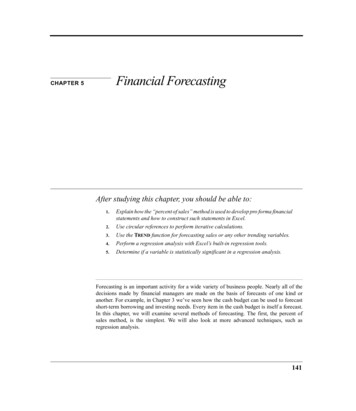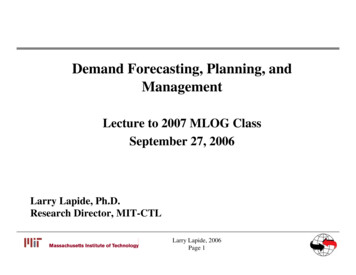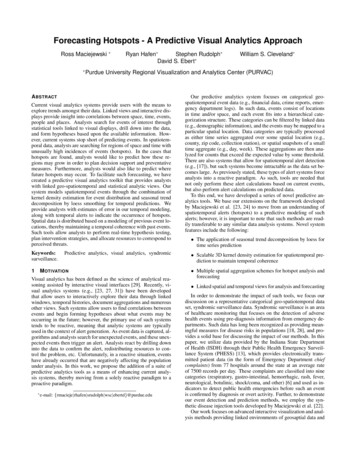
Transcription
Chapter 17FinancialForecastingand PlanningCopyright 2011 Pearson Prentice Hall. All rights reserved.
Slide Contents Learning Objectives1. An Overview of Financial Planning2. Developing a Long-term Financial Plan3. Developing a Short-Term Financial Plan Key TermsCopyright 2011 Pearson Prentice Hall. All rights reserved.17-2
Learning Objectives1. Understand the goals of financialplanning.2. Use the percent of sales method toforecast the financing requirements of afirm including its discretionary financingneeds.3. Prepare a cash budget and use it toevaluate the amount and timing of afirm’s short-term financing requirements.Copyright 2011 Pearson Prentice Hall. All rights reserved.17-3
17.1 An Overviewof FinancialPlanningCopyright 2011 Pearson Prentice Hall. All rights reserved.
An Overview of Financial Planning What is the primary objective of preparingfinancial plans?– To estimate the future financing requirementsin advance of when the financing will beneeded. The process of planning is critical to forcemanagers to think systematically aboutthe future, despite the uncertainty offuture.Copyright 2011 Pearson Prentice Hall. All rights reserved.17-5
An Overview of Financial Planning(cont.) Most firms engage (use) in three types ofplanning:– Strategic planning,– Long-term financial planning, and– Short-term financial planning Strategic plan defines, in very generalterms, how the firm plans to make moneyin the future. It serves as a guide for allother plans.Copyright 2011 Pearson Prentice Hall. All rights reserved.17-6
An Overview of Financial Planning(cont.) The long-term financial plan generallyencompasses a period of one to three/fiveyears and incorporates estimates of thefirm’s income statements and balancesheets for each year of the planninghorizon.Copyright 2011 Pearson Prentice Hall. All rights reserved.17-7
An Overview of Financial Planning(cont.) The short-term financial plan has got aperiod of one year or less and is a verydetailed (particular) description of thefirm’s anticipated (forecasted) cash flows. The format typically used is a cashbudget, which contains revenueprojections and expenses in the month inwhich they are expected to occur for eachoperating unit of the company.Copyright 2011 Pearson Prentice Hall. All rights reserved.17-8
17.2 Developinga Long-TermFinancial PlanCopyright 2011 Pearson Prentice Hall. All rights reserved.
Developing a Long-Term FinancialPlan Forecasting a firm’s future financingneeds using a long-term financialplan can be thought of in terms ofthree basic steps:1. Construct a sales forecast2. Prepare pro-forma financialstatements3. Estimate the firm’s financing needsCopyright 2011 Pearson Prentice Hall. All rights reserved.17-10
Developing a Long-Term FinancialPlan (cont.) Step 1: Construct a Sales Forecast– Sales forecast is generally based on:1. past trend in sales; and2. the influence of any anticipatedevents that might materially affectthat trend.Copyright 2011 Pearson Prentice Hall. All rights reserved.17-11
Developing a Long-Term FinancialPlan (cont.) Step 2: Prepare Pro Forma FinancialStatements– Pro forma financial statements help forecast afirm’s asset requirements needed to supportthe forecast of revenues (step 1).– The most common technique is percent ofsales method that expresses expenses,assets, and liabilities for a future period as apercentage of sales.Copyright 2011 Pearson Prentice Hall. All rights reserved.17-12
Developing a Long-Term FinancialPlan (cont.) Step 3: Estimate the Firm’s FinancingNeeds– Using the pro forma statements we can extract(introduce) the cash flow requirements of thefirm.Copyright 2011 Pearson Prentice Hall. All rights reserved.17-13
Financial Forecasting Example Table 17-1 illustrates how Ziegen, Inc.uses the percent of sales method toconstruct pro forma income statement andpro forma balance sheet. The company uses the three-stepapproach to financial planning.Copyright 2011 Pearson Prentice Hall. All rights reserved.17-14
Financial Forecasting Example(cont.) Step 1: Forecast Revenues and Expenses– Zeigen’s financial analyst estimate the firm willearn 5% on the projected sales of 12 millionin 2010.– Zeigen plans to retain (keep) half of itsearnings and distribute the other half asdividends.– See Table 17-1Copyright 2011 Pearson Prentice Hall. All rights reserved.17-15
Financial Forecasting Example(cont.) Step 2: Prepare Pro Forma FinancialStatements– The firm’s need for assets to support firm salesis forecasted using percent of sales method,where each item in the balance sheet isassumed to vary in accordance with itspercent of sales for 2010.Copyright 2011 Pearson Prentice Hall. All rights reserved.17-16
Financial Forecasting Example(cont.) Step 3: Estimate the Firm’s FinancingRequirements– This involves comparing the projected level ofassets needed to support the sales forecast tothe available sources of financing.– In essence, we now forecast the liabilities andowner’s equity section of the pro forma balancesheet.Copyright 2011 Pearson Prentice Hall. All rights reserved.17-17
Financial Forecasting ExampleCopyright 2011 Pearson Prentice Hall. All rights reserved.17-18
Sources of Spontaneous Financing –Accounts Payable and Accrued Expenses Accounts payable and accrued expensesare typically the only liabilities that varydirectly with sales. Accounts payable and accrued expensesare referred to as sources ofspontaneous financing. The percent ofsales method can be used to forecast thelevels of both these sources of financing.Copyright 2011 Pearson Prentice Hall. All rights reserved.17-19
Sources of Discretionary Financing Raising financing with notes payable, longterm debt and common stock requiresmanagerial discretion and hence thesesources of financing are calleddiscretionary sources of financing. The retention of earnings is also adiscretionary source as it is the result offirm’s discretionary dividend policy.Copyright 2011 Pearson Prentice Hall. All rights reserved.17-20
Summarizing Ziegen’s FinancialForecast (cont.)Copyright 2011 Pearson Prentice Hall. All rights reserved.17-21
Summarizing Ziegen’s FinancialForecast Discretionary Financing Needs (DFN) {Total Financing Needs} less {ProjectedSources of Financing} { 7.2 m (increase in assets)} – { 2.4m inspontaneous financing 2.5m in short andlong-term debt 1.8 million in equity} 7.2 million - 6.7 million 500,000Copyright 2011 Pearson Prentice Hall. All rights reserved.17-22
Summarizing Ziegen’s FinancialForecast (cont.) The firm has to raise 500,000 with somecombination of borrowing (short-term orlong-term) or the issuance of stock. Since they require a managerial decision,they are referred to as the firm’sdiscretionary financing needs (DFN).Copyright 2011 Pearson Prentice Hall. All rights reserved.17-23
An Overview of Financial Planning (cont.) Most firms engage (use) in three types of planning: –Strategic planning, –Long-term financial planning, and –Short-term financial planning Strategic plan defines, in very general terms, how the firm plans to make money











